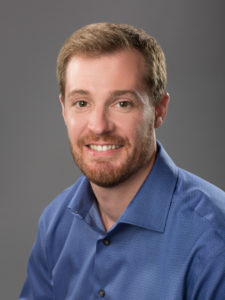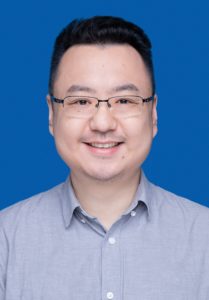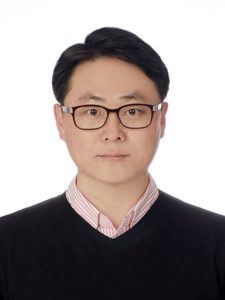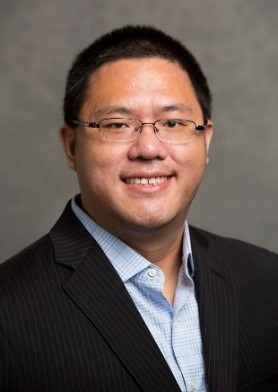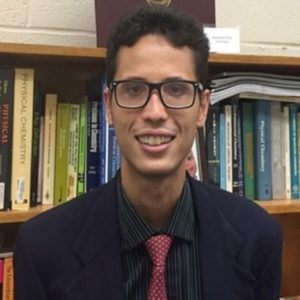 I am Alexandre H. Pinto, popularly known as Alex Pinto. I have been an Assistant Professor in the Department of Chemistry and Biochemistry at Manhattan College in New York City since Fall 2019. My research combines concepts of nanoparticle synthesis, experimental kinetics and thermodynamics studies of water environmental remediation, mainly by adsorption and photocatalytic mechanisms.
I am Alexandre H. Pinto, popularly known as Alex Pinto. I have been an Assistant Professor in the Department of Chemistry and Biochemistry at Manhattan College in New York City since Fall 2019. My research combines concepts of nanoparticle synthesis, experimental kinetics and thermodynamics studies of water environmental remediation, mainly by adsorption and photocatalytic mechanisms.
A little bit about myself, I was born and raised in Brazil. I also obtained my Bachelor’s degree in Chemistry and a Master’s degree in Physical Chemistry there, at Universidade Federal de Sao Carlos. Then, I moved to the USA for Graduate School. I obtained my Ph.D. in Chemistry from the University of Minnesota in 2017, advised by Prof. R. Lee Penn.
Read Alexandre Pinto’s Emerging Investigator article “Emerging investigator series: Photocatalytic membrane reactors: fundamentals and advances in preparation and application in wastewater treatment” and read more about him in the interview below:
How did you decide on your current research field?
The focus of my Ph.D. research was the synthesis of nanoparticles of transition metal sulfides using the microwave as a heating method, mainly envisioning thin films preparation for solar cell applications. Although my research at that time had been rooted in the Green Chemistry Principles, there was no correlation to water remediation and its kinetics studies. I started to get interested in this area when I was working with an undergraduate Summer student, and one of the compounds we prepared seemed to have some photocatalytic activity. That eventual finding got me starting on reading the literature, learning about the adsorption and photocatalysis setups and calculations. I could not take to fruition these fields during my Ph.D. research, so, in my spare time, I used to brainstorm how I could implement it when I became a Principal Investigator. By the time I graduated, I felt intellectually equipped to implement these ideas as soon as a chance appeared.
And when could you finally implement these ideas?
My contact with undergraduate students during Graduate School revealed that I would like to be a Professor in a Primarily Undergraduate Institution (PUI). These schools are common in the USA. They are institutions that work mostly with undergraduate students, offering undergraduate degrees. Some of them usually offer Masters’s degrees, but not Ph.D. degrees.
So, in my last year in Graduate School, I started applying for positions in PUIs, and I was fortunate to get a job in Ithaca College, in Ithaca, NY state. This position was very particular regarding its attributions. Officially it was called Postdoctoral Teaching and Research Scholar. In practice, it was very similar to a Visiting Assistant Professor Position. I say that because I had to develop my own courses and received support from the Department to conduct my own research group with my own ideas and undergraduate advisees. And that is when I consider the birth of the Alex Pinto group, in Fall 2017. It was when I could start implementing my first ideas about photocatalysis and adsorption studies.
Those two years that I worked in Ithaca College were wonderful. I was fortunate to work with amazing students and supportive colleagues, who gave me the confidence that I was on the right path. That time was so productive that our group ended up publishing five peer-reviewed articles from the research started at that time. We also received the best poster presentation in one ACS regional Meeting (ACS Northeast Nanomaterials Meeting, Lake Placid, NY, June 2018), and one ACS National Meeting (at 257th American Chemical Society National Meeting, in Orlando, FL, April 2019). But even more important to that was the opportunity to help the former students from our group to get into the job, Master’s or Ph.D. Programs from their choice, by writing recommendation letters, helping them crafting their materials, and talking to potential employer’s calls.
So, talk more about the article you published in the Emerging Investigator Series?
The article published in the Emerging Investigators Series is a tutorial review called “Photocatalytic membrane reactors: fundamentals and advances in preparation and application in wastewater treatment”. My collaborator in this project was Professor Mahbubhoor Choudhury, from the Manhattan College Department of Environmental Engineering. This article talked about the fundamentals and state of the art of photocatalytic membrane reactors (PMRs). These reactors combine the filtering and photocatalytic degradation processes to eliminate pollutants from wastewater. We included papers describing both lab-scale simulated wastewater and pilot-scale real matrices wastewater. We also covered different types of pollutants, such as pharmaceutical molecules and antibiotic-resistant bacterias. There are topics about antifouling properties of the PMRs too. We also tried to include our viewpoints about the future developments in the PMRs fields.
How did the idea to write this review article came up?
I first received the invitation from editorial office in early Summer 2020. Due to the journal’s scope, I thought it appropriate to write a tutorial review about photocatalytic membranes, which is the area the groups of Prof. Choudhury and mine had started collaborating. Unfortunately, by that time, the labs were all closed due to the covid-19 restrictions. So, we could not envision much advancement in our experimental research by that time. This fact indicated to us that the review article would be the best decision at that time. Then, the Environmental Engineering Master student Andrew Ashley and the undergraduate Biochemistry major Brandon Thrope worked on writing about half of the article. The other half was divided between Professor Choudhury and I. We also compiled and edited the version submitted to the journal.
And since the tutorial review article elaboration, how has your research evolved?
Since then, we have been glad to be funded by a research grant from the American Chemical Society Petroleum Research Fund (ACS-PRF). In this project, we have been working on developing photocatalytic membranes for the desulfurization of simulated fuels. The students in my group are now specifically working on methods to prepare composites of graphene oxide and titanium dioxide (TiO2), aiming to use these composites as active materials in the photocatalytic membranes. If everything works as planned, we hope to advance to membranes preparation in the next few months. Once the membranes are prepared, we can start studying them both in the batch and flow regimes for water pollutants photocatalytic degradation and photocatalytic desulfurization.
Here, I can not refrain to cite our collaborators in these projects. Since, I first started at Ithaca College, I have kept collaborating with Professor Nirupam Aich, from the Civil and Environmental Engineering at University of Buffalo. Professor Aich and his students have been essential for us to characterize the materials using the techniques we do not have in Manhattan College, such as scanning electron microscopy. Another long-time collaborator is Prof. Rajesh Sunasee from the State University of New York (SUNY) in Plattsburgh. Prof. Sunassee provide us functionalized cellulose nanocrystals, which we have used for the kinetic studies of simulated wastewater remediation. A local collaboration that we will benefit from in the later stages of the project is Prof. Anton Oliynyk, who is my department colleague at Manhattan College. Prof Oliynyk will be working closely with our students on applying computational methods to adsorption different molecules on the surface of these membranes. We also have a couple of international collaborators, mostly from Brazil, such as Dr. Jose Clabel, from the University of Sao Paulo Institute of Physics of Sao Carlos, and Prof. Luiz Fernando Gorup, from Federal University of Alfenas Institute of Chemistry, from both of them we have collaborations on different types of metal oxide nanoparticles preparation and characterization.

Dr. Mahbuboor Choudhury and Dr. Alexandre H. Pinto, the corresponding authors in the Tutorial Review published in the Emerging Investigator Series.
What aspect of your work are you most excited about at the moment?
At this moment, I am excited about how the metal oxide nanoparticles shapes are going to impact the photocatalytic activity of the membranes, considering that these metal oxide nanoparticles are the photocatalytic active components of the membrane.
In your opinion, what are the most important questions to be asked/answered in this field of research?
How to make the photocatalytic membranes have higher photocatalytic activity on the visible range of the electromagnetic spectrum. Usually, doping is a possible strategy, but not all doping ions would be indicated as safe to be present in a membrane to be applied in a real wastewater treatment plan. So, other strategies to tune the band gap of these materials should be sought.
In which upcoming conferences or events may our readers meet you?
Usually, I attend the ACS National Meetings, at least one of them per year. I am looking forward to the events resuming to be attended in person safely. So, I can start attending the ACS National Meetings again.
How do you spend your spare time?
I enjoy spending my spare time with my wife and my two kids: a toddler boy and a baby girl.
What do you find most challenging about your research?
Photocatalytic membranes combine different materials in the membrane. So, the preparation of each individual material is already a challenge. Then, once we know how to prepare them individually, the next challenge is to make them a singular material with the desired functional properties of the membrane.
Which profession would you choose if you were not a scientist?
Since I started taking choosing a profession more seriously, I always envisioned myself teaching. So, probably I would be a teacher in some other capacity, maybe a high school teacher. When I was younger and thought of profession only to be a hobby-related choice, I would probably be a soccer reporter or commentator and a writer in some capacity.
Who are your role models in science?
My role models are always people who worked with me during these years, and they all contributed immensely to getting the scientific background and knowledge that I have. In this group of people, I usually cite four scientists/educators. The first one is Prof. Emerson R. Camargo, who got me started in chemistry research when I was undergrad. I worked with him for almost six years, combined undergraduate and Master’s degrees in Universidade Federal de Sao Carlos. Then, my Ph.D. advisor, Prof. R Lee Penn from the University of Minnesota. It was a pleasure working on her group all those years in Graduate School. It is great to work with an advisor who is reputable not only for her scientific endeavors but also for her activism for minorities, diversity, equity, and inclusion. Third, I would like to remark on Prof. Eray Aydil, now at NYU Tandem School of Engineering, in NY. We worked closely when he was still working at the University of Minnesota Department of Chemical Engineering and Materials Science. He was a co-PI in a project with my advisor, and we used to have group meetings every other week. I really admire his capacity to have abundant ideas about the paths a project should take based on the preliminary results presented. And finally, I am also really grateful for the opportunity to work with Prof John Dwyer from Saint Catherine University in Saint Paul, Minnesota. Prof Dwyer had many decades of teaching experience in PUI. I first met him when he was spending a sabbatical period in Prof Aydil group. Knowing about Prof Dwyer’s immense teaching experience, I asked if he could mentor me in this process, which he gladly did. His mentorship and experience were great for making me better prepared for the academic job market.
Can you share one piece of career-related advice or wisdom with other early career scientists?
Do not be discouraged because of negative feedback of reviewers on manuscripts and proposals. Believe in your own motivation and resilience. Although some reviewers are very offensive in their comments to early career scientists, try to not take these comments personally. Maybe that reviewer is on a bad day or was not trained to express their opinions in a more polite way. It does not mean, at all, that you are incapable to that proposed idea to fruition.
Dr. Pinto, is your group present on any social media?
Yes, we are very active on Twitter. Our Twitter handle is @AlexPintoGroup. Twitter has been a very useful tool for interacting with other research groups and knowing more about their research. We also have our official website www.alexpintogroup.com.
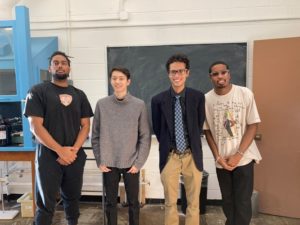
Dr. Alexandre H. Pinto, and the undergraduate students from his group, in Fall 2021. From left to right: Donovan Vincent, Dylan Cho, Dr. Pinto, and Malik Williams.
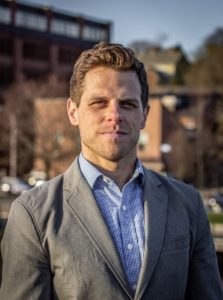 Joe Goodwill is currently an Assistant Professor in the Civil and Environmental Engineering Department in the College of Engineering at the University of Rhode Island, a position he started in the fall of 2017. In this appointment he executes research in physical-chemical processes, water quality, and water-poverty issues. He also teaches classes focused on water treatment and reuse, and environmental analytical techniques. His Ph.D. and M.S. degrees in Civil Engineering are from the University of Massachusetts Amherst. He also holds a B.S. in Civil Engineering from Lafayette College. Prior to entering academia, Joe was a Project Engineer for Black & Veatch working on global projects out of their Philadelphia office. He is a licensed Professional Engineer (PE), and a Leadership in Energy and Environmental Design (LEED) Accredited Professional. Joe also works with multiple international water NGOs, supporting projects in Malawi, India, Ghana, and Bolivia. He received an NSF Faculty Early Career Development Award in 2021.
Joe Goodwill is currently an Assistant Professor in the Civil and Environmental Engineering Department in the College of Engineering at the University of Rhode Island, a position he started in the fall of 2017. In this appointment he executes research in physical-chemical processes, water quality, and water-poverty issues. He also teaches classes focused on water treatment and reuse, and environmental analytical techniques. His Ph.D. and M.S. degrees in Civil Engineering are from the University of Massachusetts Amherst. He also holds a B.S. in Civil Engineering from Lafayette College. Prior to entering academia, Joe was a Project Engineer for Black & Veatch working on global projects out of their Philadelphia office. He is a licensed Professional Engineer (PE), and a Leadership in Energy and Environmental Design (LEED) Accredited Professional. Joe also works with multiple international water NGOs, supporting projects in Malawi, India, Ghana, and Bolivia. He received an NSF Faculty Early Career Development Award in 2021.













